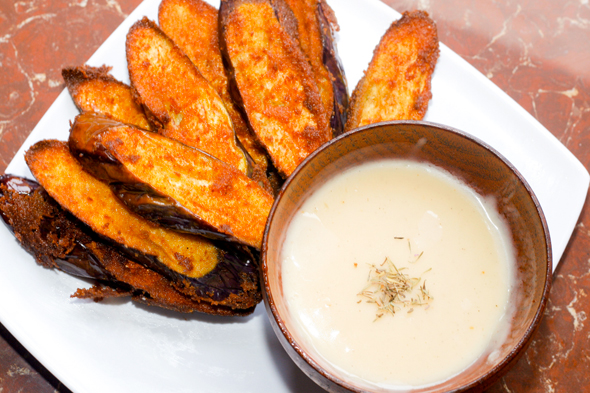Baingan De Pakore (Fried Eggplant Fritters)
One of the joys of rainy weather is sitting down with a hot cup of tea and “garma-garam” (piping hot) pakoras (fried fritters). Below is a reprint of Mama’s Baingan De Pakore recipe, which can be a meal by itself, with some nice chutney, and keeps you warm on a wet, muggy day. It is reprinted with some additional information and directions.
Pakoras – as well as samosas – have become so popular worldwide that these Indian snacks have become universal world foods, like quiche, donuts, dumplings and sushi. Pakoras are inexpensive and quick to make, and they are hard to resist: if you eat one, you’ll probably not stop and will eat many more. And among the vegetable variety, baingan (eggplant) pakoras have a unique taste that people really enjoy.
Because pakoras are essentially vegetables covered in batter and then fried (though some make paneer or meat ones too), people sometimes make a whole meal, rolling them up in a roti, and eating it with a little chutney. What makes all the difference in taste is the spicy chickpea flour batter or besan and then deep frying it.
When making pakoras, not all vegetables turn out tasting the same, and the usual ones used are potatoes, onions, cauliflower, sometimes fresh methi (fenugreek) leaves, and of course, paneer. But, I have realized that one overlooked vegetable is baingan (eggplant), usually sliced length-wise and about an inch thick to give the best taste. And of course, pakoras need to eaten hot from the frying pan in order to be best appreciated.
In some places, pakoras are made of singhara atta (water chestnut flour) but the taste is not as satisfying as using besan. Other forms of pakoras are the tempura batter in Japanese cuisine or the chicken nuggets that are so popular these days.
Ingredients:
• 1.5 cups besan (chickpea flour)
• Water – enough to make a running paste
• 1 medium baingan (eggplant) – round or long
• 2 cups tael (vegetable oil) for deep frying
• ½ tsp ajwain (carom seeds)
• Spices to taste: namak (salt), mirch (red pepper)
Directions:
1. Wash the eggplant and cut length wise, about 4 inches long, and about 1 inch thick slices. Eggplant cut in round slices doesn’t give the same taste.
2. Place the sliced eggplant in a bowl and sprinkle with namak and mirch and let them stay for 30 minutes to marinate the vegetable.
3. In a bowl, pour 1.5 cups of besan, mix in ajwain, namak and mirch and then while slowly pouring in water, knead the dough till it becomes a soft, running paste.
4. Heat the oil in a karahi (wok). Throw in a small dab of batter to make sure the oil is very hot. Take a slice of eggplant, dip it into the batter then release it into the hot oil. Keep doing this till the surface of the oil is covered with battered pieces.
5. When one side is slightly brown, turn it over using a sieved spatula and turn over a few times to make sure both sides are cooked. Be careful that they do not become dark brown. Take them out and place on a paper towel to absorb the extra oil.
6. Serve hot with some tomato ketchup or mint or tamarind chutney.
MAMA’S TIP OF THE WEEK: KEEP TEA AND COFFEE STAINS OFF CUPS AND MUGS
Many people will enjoy their morning – or afternoon – tea or coffee and then just leave their cups or mugs on the counter, waiting to clean them later. If you do this often enough, you’ll soon see a stain develop in the cup or mug and after awhile, the brown stain is hard to remove, as you have to scrub hard to get them off.
The best way to avoid the brown stain, if you can’t wash it right away, is to just fill your cup or mug half way with water and let it sit till you can wash them, The stains won’t be able to set into the ceramic and your cup or mug will stay white for a long time.

Shakuntla Malhotra is a skilled cook of Punjabi dishes made in the old-fashioned style that she learnt as a young woman in her ancestral home in Lyallpur, India (since renamed Faisalabad) before it became part of Pakistan after the Partition in 1947. People have often admired her cooking for its simplicity and taste that comes with each mouthful. Even in her late-eighties, she continues to cook daily and agreed to share her delectable Punjabi vegetarian recipes for future generations.

